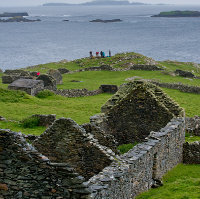
This June, Ian Kuijt, professor of anthropology and Keough-Naughton Institute for Irish Studies fellow will direct the Notre Dame Irish Historical Archaeology field project on Inishark, a remote island off the west coast of Ireland.
The project draws on the success of earlier field work undertaken on the islands of Inisbofin and Inishark, County Galway, Ireland where significant gains were made in understanding island life. Once home to a vibrant community but abandoned in the 1960’s, Inishark’s remains provide a unique window into life in western Connemara from the 1750’s trough the 1950's.
The project, in the past open only to Notre Dame undergraduate and graduate students, this year welcomes interested students from other institutions. Students will earn academic credit for the three week field course.
According to Professor Kuijt, the team will focus on two initiatives: a detailed excavation of a buried and well preserved sod and stone house dating to 1870 and the excavation of part of a 7th-10th century enclosure with an oratory, or small chapel, as well as exploratory excavations of a nearby water mill which dates to the 10th -12th century. The project will expose students to the early medieval period in addition to post 17th century island life.
The overall aim is to “document how residential and economic practices within the fishing village of Inishark changed with Irish national policies of improvement, changes in land ownership and local change at the community and household level due to immigration and famines from the 1850’s through the 1890’s,” says Professor Kuijt.
The 2014 Notre Dame Irish Historical Archeology field excavation is an extension of past Cultural Landscapes of the Irish Coast projects funded by the Keough-Naughton Institute and the Ireland Council. The Cultural Landscapes of the Irish Coast initative seeks to research, document and ultimately preserve island culture and heritage.
Interested students are encouraged to visit the website: http://clicproject.wordpress.com/.
Learn more►